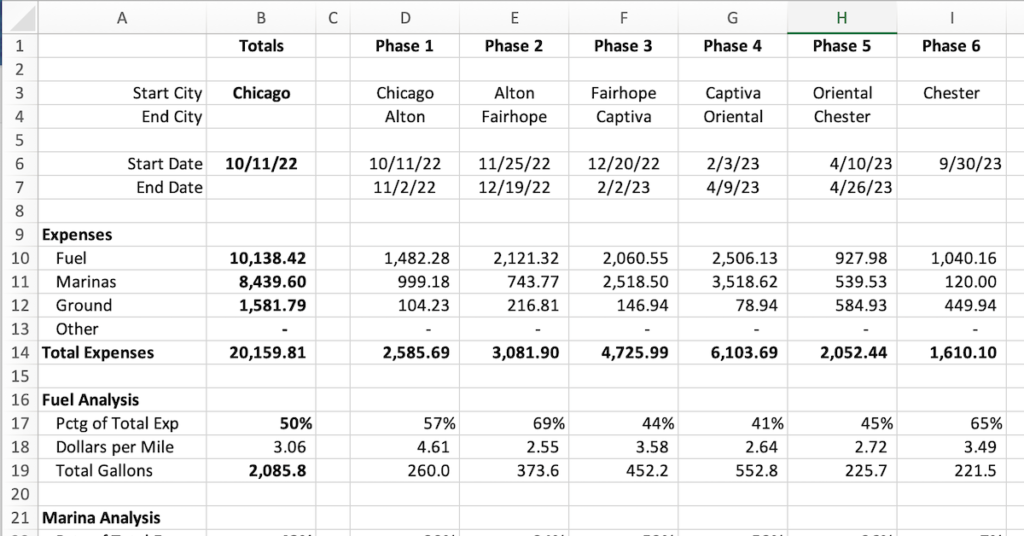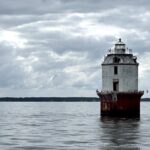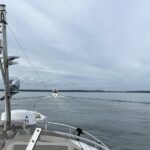I review the statistics — including finances — of this adventure.
I just finished bringing my Excel worksheet full of trip information up-to-date and thought I’d take a minute to share the info with folks interested in the numbers behind this adventure.
The Boomerang Loop
As I write this, I’m at an anchorage at Cobb Island, MD, just off the Potomac River.
Attentive readers may have noticed that I’m moving south instead of north. That’s because leaving the boat in late April until late September made it impossible for me to complete the Great Loop before cold weather closed the Erie Canal and other facilities in the north. So I’m heading south, probably to Florida, which will not only increase the time spent doing the loop, but also the miles and expenses related to it. I’m calling this a “boomerang loop,” since I’ll be backtracking along the ICW before heading north again.
That said, this is probably a good time to review my expenses so far since they are mostly related to doing the Loop without the boomerang part.
Miles and Time
So far, I’ve spent a total of 197 days on board Do It Now since October 11, 2022 when I officially started the Loop in Chicago, IL. Of those days, 150 have been solo; I had a friend on board from Chicago to Alton and another friend on board from Alton to Mobile.
You cannot schedule your time on the loop. Stuff happens.
Trying to plan out your entire trip with where you’re going to stay and when you’re going to stay there is an exercise in futility. You will inevitably be delayed by weather or mechanical issues with locks and bridges. And then there are the mishaps and mechanical issues related to your boat. You’ll reach a destination you really like and want to stay a few days more. Or you’ll reach a destination you don’t like and won’t want to stay at all. And then there’s the “must see” destinations where you can’t get a reservation. Or the family emergencies that force you to dock your boat, hop on a plane, and go home for who knows how long.
I try to plan about 4 to 7 days at a time. This helps me plan around weather while still being able to book a slip at a marina I want to stop at along the way. It also helps keep me focused on a destination every day. But ask me where I’ll be for Thanksgiving — which is still more than a month away — and I have absolutely no clue.
I’ve spent a total of 93 days actually cruising. That’s a little less than half the days. I like to spend one or two nights at each destination, but I spent seven at Orange Beach AL, seven at Steinhatchee FL, and seven at Fort Pierce FL. I also spent three or more at a handful of other places. Sometimes I spend more time because a place is interesting, but it’s more likely that I stay because I’m held up an extra day or two because of weather.
I’ve cruised a total of 3,315 miles in 427 cruising hours. That’s an average of 35.6 miles and 4.6 hours per cruising day. My cruising speed ranges from 5 or 6 knots in no wake zones to 17 knots when I was at full throttle racing to make a draw bridge the operator was holding open for me. And there was lots of waiting for locks on the inland waterways.
Accommodations
My overnight accommodations have been a mix of marinas (150 nights), free docks/walls (24 nights), and anchorages (23 nights). Marinas have cost me a total of $8,440 or 42% of my total expenses so far. Ouch.
When I returned to the boat about two weeks ago, I decided to make a conscious effort to save money by anchoring out instead of staying at increasingly more costly marinas. This is easier now because of the new Olssen dinghy davit I had installed on my boat. The davit makes it possible to keep my 46 pound outboard motor on the dinghy instead of having to install and uninstall it when I launch or stow the dinghy. This is a game changer for me since I need to take my pups to shore three times a day to do their business. It used to be a real chore to get the dinghy launched or stowed but now it’s quick and easy.

One of the benefits of anchoring out is the numerous opportunities to get good photos of my boat from the water. Here it is at Belmont Bay anchorage yesterday morning.
Since returning to the boat and getting under way, I’ve anchored out nine of the 20 nights. Most of the remaining nights were spent at free docks. I figure that I save about $80 per night (on average) that I anchor out so I’m pretty motivated to do it as much as possible.
Understand that my boat is extremely well suited to anchoring out. It has very low power usage, charges its batteries while under way, and has a 160 watt solar panel that can add more power than consumed by always on systems (refrigerator, bilge pump, etc.) on a sunny day. I have a Honda portable generator on board but haven’t used it once; in fact, I’ll be taking it home in spring. My power usage is so low that I often turn down shore power when a marina I’m staying at charges an additional fee. (Those $10 per night fees really do add up, folks.)
Fuel
Of course, my biggest expense is the diesel fuel my boat burns. So far, I’ve spent $10,138 on the 2,086 gallons I’ve burned. Fuel accounts for 50% of my trip expenses and my current fuel cost per mile is about $3.06.
Prices range from $3.99 per gallon to over $6 per gallon. I actively look for cheap fuel and plan my route to take advantage of it. If I can save $1 per gallon on 100 gallons of fuel, that’s $100 saved.
I can save fuel by cruising at a much slower rate — maybe 6 knots or slower? That’s how Captain John did it in his twin engine Carver. But 6 knots is a bit too slow for me. I get decent fuel economy at 9-10 knots and then again at 14-15 knots. (This is calculated by my chart plotter using live fuel burn data from my engine computer; in between those two speeds, economy drops off considerably.)
I can also save fuel by planning cruise times to benefit from tidal flows or river currents. You’d be surprised at the fuel economy bump you get with a one knot current in your favor.
Ground Transportation
My final trip-related expense is ground transportation — rental cars and Uber/Lyft/Taxi services: $1,582 so far. This includes the cost of one-way car rentals I used to get from the boat to the nearest airport when I was in Alton and on Kent Island. I can easily get this cost under control with better planning.
I already save a ton of money on local ground transportation with my e-bike, which I just replaced. It’s easy for me to bike 5 miles or more (if necessary) for groceries or to take in local attractions. I believe that some sort of ground transportation on board is vital for Loopers interested in saving money. A foldable e-bike works great for me, but I’ve also seen other folding bikes and scooters.
Maintenance
I need to update my worksheet to include maintenance expenses like oil and filter changes. I change my oil and filters once every 150 engine hours or so. Because I do it myself, I save the cost of labor, but the filters and oil still cost about $200 per change.
There’s other maintenance too, like replacing the zincs and impeller and servicing the cooling system. These aren’t things I can do myself and, in the case of the zincs, they require either a diver or a haul out.
Other Expenses
I don’t track my expenses for groceries, eating out, or doing laundry. I have to eat no matter where I am and the laundry expense is usually minimal. I also don’t track the cost of any tourist things I do because, again, I’d likely be doing things to stay entertained no matter where I was.
The Bottom Line
If you add up my three tracked expenses — overnight accommodations, fuel, and ground transportation totaling $20,160 (!) — and divide that by the number of days on the Loop (197), the current average is $102.33 per day.
My goal is to get that average down to about $60-$70 per day. I think I can do it.
(I wrote a whole article about saving money while cruising. I was hoping to get it published by Waterway Guide, but if I can’t, it’ll show up here. Keep checking in.)



This is interesting: “…fuel economy at 9-10 knots and then again at 14-15 knots.” The boat is displacement hull, yeah? What is happening dynamically between those two speeds? Enquiring minds…LOL
It’s a semi displacement hull. I think I start getting better fuel economy again at that higher speed because more of the hull is out of the water. But it never quite comes up on plane.
Thanks Maria for sharing your journey and the details that go along with it. I have a 2017 Ranger 29CB.
Ray
Doing the Loop? Or just cruising? Our boats are perfect for looping!
My RT31 gets 1.5 miles to the gallon up on step to do 14-15 knots – somewhere around 2800-2900 rpm. It gets the same mpg to go max speed, but at 3000+ RPM, my heat exchanger won’t keep up in the warm Florida waters. Hull speed on the RT31 is about 6 knots and I’m training myself to enjoy the go at that speed – i.e. 1400 rpm gets me to hull speed and I can achieve 5 mpg. If I can make my destination at that speed, then I keep it between 1400-1500 and maximize the fuel savings. Increasing RPM up to 1700 gains maybe 1/2 knot in speed but the fuel economy starts to significantly drop. At 8-10 knots the mpg is actually worse (1.2 mpg) than getting her up on step.
Thanks for all of this info. I’m still gathering data but I’m also seeing better fuel economy at 3000 RPM than 2500 RPM (for example). I go “slow” — around 8 knots — where things are interesting and tend to speed up — like to 14 or 15 knots — in boring places. A compromise. I don’t think I could do 6 knots all day if I had a lot of miles to cover.